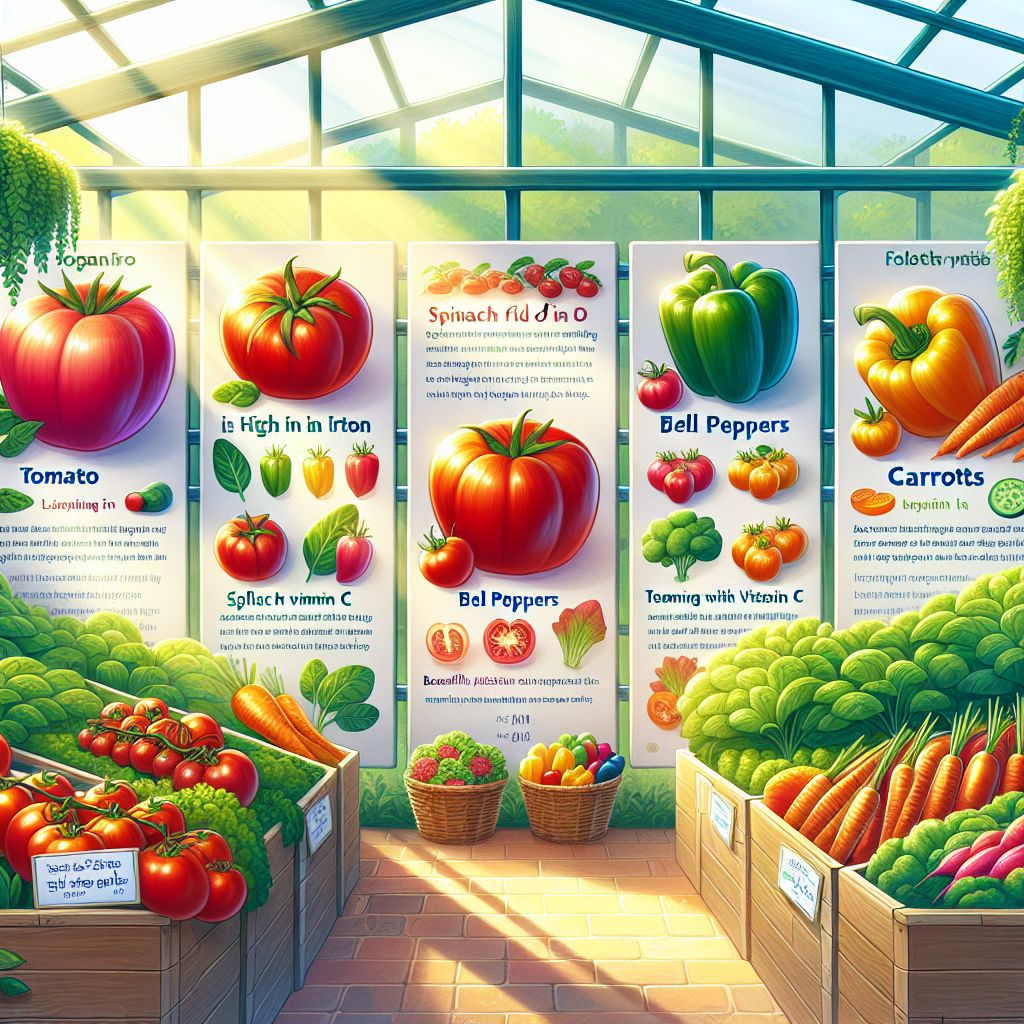Key Takeaways
-
Greenhouse vegetables are often more nutrient-dense due to controlled growing conditions.
-
Choosing greenhouse-grown produce can lead to a reduction in pesticide consumption.
-
Greenhouse farming is environmentally friendly, conserving water and reducing transportation emissions.
-
Incorporating a variety of greenhouse vegetables into your diet can improve overall health.
-
Simple recipes and snack ideas can help you easily add more greenhouse veggies to your meals.
The Nutritional Edge of Greenhouse-Grown Produce
Have you ever wondered why greenhouse-grown vegetables are becoming increasingly popular? It’s not just about the year-round availability, it’s also about the nutritional benefits they bring to the table. When you bite into a crisp, vibrant greenhouse vegetable, you’re experiencing the pinnacle of plant nourishment.
Packed with Essential Vitamins and Minerals
Let’s dive into what makes these veggies so special. Greenhouse vegetables are grown in a meticulously monitored environment. Because they are shielded from harsh weather and pests, they can be cultivated without the heavy use of chemicals. This means you get produce that’s not only safer to eat but often richer in vitamins and minerals.
For instance, tomatoes grown in greenhouses can have higher levels of vitamin C and antioxidants like lycopene when compared to their field-grown counterparts. This is because the controlled conditions of a greenhouse allow for optimal nutrient uptake from the plant to the fruit.
How Greenhouses Enhance Plant Nutrient Uptake
So, how do greenhouses manage to boost the nutritional content of vegetables? It’s all about the environment. In a greenhouse, everything from the temperature to the amount of light and water the plants receive is regulated. This controlled setting minimizes stress on the plants, allowing them to absorb nutrients more efficiently and grow to their full potential.
Why Choose Greenhouse Vegetables?
When you’re standing in the produce aisle, you might be faced with a choice between greenhouse-grown and regular vegetables. Here’s why you might lean towards the former.

Peak Freshness Equals Maximum Nutrition
Most importantly, the freshness of greenhouse vegetables is unmatched. They are often picked and sold within a day, ensuring that they retain their maximum nutritional value. Vegetables lose nutrients as they age, so the quicker they go from farm to table, the better for you.
Besides that, greenhouse vegetables are consistently available, regardless of the season. This means you can enjoy your favorite veggies and their health benefits all year round, without having to wait for the right season.
Say Goodbye to Harmful Pesticides
Because greenhouse plants are protected from many pests and diseases, they require fewer pesticides. This means you’re less likely to consume the harmful chemicals often found on traditionally grown produce. It’s a win for your health and peace of mind.
Let’s put it simply: opting for greenhouse vegetables is a smart choice for both your body and the environment. Stay tuned for more insights on how these nutrient powerhouses can fit into your daily diet and contribute to a greener planet.
Environmental Perks of Greenhouse Farming
Now, let’s talk about the environment. It’s no secret that we need to make changes to protect our planet, and choosing greenhouse vegetables is a step in the right direction. Greenhouse farming has some significant environmental advantages that are worth considering.
Conserving Water with Recycled Systems
Greenhouses are champions of water conservation. They often use hydroponic systems, which recycle water and nutrients, using up to 90% less water than traditional soil farming. This is especially important in areas where water is scarce. By choosing greenhouse veggies, you’re supporting a more sustainable use of our precious water resources.
Reducing the Carbon Footprint by Growing Local
Moreover, greenhouse vegetables are typically grown closer to where they’re sold, which reduces the carbon emissions associated with long-distance transportation. This means that by eating these veggies, you’re helping to reduce the carbon footprint of your food. It’s a simple yet effective way to contribute to a healthier environment.
Greenhouse farming also allows for more efficient use of land, producing higher yields in a smaller area. This means less land is needed for agriculture, which can help preserve natural habitats and biodiversity.
Incorporating Greenhouse Veggies in Your Diet
So, how can you start incorporating more greenhouse veggies into your meals? It’s easier than you might think, and the benefits for your health are well worth the effort.
Simple Tips for Everyday Healthy Meals
Start by swapping out some of your regular veggies for greenhouse-grown varieties. You can use them in all the same ways: raw in salads, roasted as a side dish, or blended into smoothies. The key is to start making small changes that can lead to a healthier eating pattern over time.
Another tip is to plan your meals around the vegetables you have. For example, if you have a bunch of greenhouse-grown tomatoes, why not make a tomato-based sauce for pasta or a fresh salsa? This way, you’re ensuring that your meals are not only delicious but also packed with nutrients.

“12 Best Greenhouse Vegetables to Grow …” from www.lovetoknow.com
Snack Ideas: From Greenhouses to Your Kitchen
And don’t forget about snacks! Greenhouse veggies make great healthy snacks. Try slicing up some cucumbers or bell peppers and dipping them in hummus. Or, for a quick and tasty treat, snack on some cherry tomatoes. They’re sweet, juicy, and full of flavor — and they make the perfect bite-sized snack.
Remember, the goal is to make eating healthy easy and enjoyable. With greenhouse veggies, you’re getting the freshest, most nutrient-dense produce available. So, get creative in the kitchen and have fun with it!
-
Use greenhouse veggies in place of regular veggies in your favorite recipes.
-
Plan meals around the greenhouse produce you have on hand.
-
Keep it simple with raw or minimally cooked preparations to preserve nutrients.
-
Snack on raw greenhouse veggies for a quick, nutritious bite.
Boosting Your Health with Specific Greenhouse Vegetables
While all vegetables are good for you, some greenhouse-grown veggies are true nutritional powerhouses. Let’s take a closer look at a few of them.
The Powerhouses: Tomatoes, Peppers, and Cucumbers
Tomatoes are a great source of vitamins A and C, potassium, and the antioxidant lycopene, which has been linked to many health benefits, including reduced risk of heart disease and cancer. Peppers, both sweet and spicy, are high in vitamin C, various B vitamins, and antioxidants. Cucumbers, while lower in vitamins, are incredibly hydrating and contain important minerals like potassium and magnesium.
By including a variety of greenhouse vegetables in your diet, you’re not only getting a spectrum of nutrients but also helping to protect your body from chronic diseases. It’s a tasty way to boost your health and contribute to a sustainable future.
So, the next time you’re at the grocery store, reach for those greenhouse grown veggies. Your body (and the planet) will thank you!

FAQ
-
Greenhouse vegetables are grown in controlled environments, which can lead to higher nutrient content.
-
Some greenhouse vegetables are organic, depending on the farming practices used.
-
Greenhouse farming can have a positive environmental impact by conserving water and reducing transportation emissions.
-
Including greenhouse vegetables in your diet can provide a variety of nutrients that contribute to overall health.
-
There are many simple and delicious recipes for incorporating greenhouse vegetables into your meals and snacks.
What Makes Greenhouse Vegetables Different from Regular Veggies?
Greenhouse vegetables are grown in an environment where temperature, humidity, and light are controlled to create optimal growing conditions. This level of control allows for year-round production, consistent quality, and often a higher nutrient content than vegetables grown outdoors. Greenhouse growers can also manage pests and diseases more effectively, reducing the need for pesticides.
Are Greenhouse Vegetables Organic?
Whether greenhouse vegetables are organic depends on the farming practices of the greenhouse. If a greenhouse uses organic methods, such as natural pest control and organic fertilizers, and is certified by a recognized organic certification body, then its produce can be labeled as organic. However, not all greenhouse vegetables are organic, so it’s important to check the labeling or ask the grower if you prefer organic produce.
It’s worth noting that organic certification standards vary by country, so the criteria for what constitutes organic greenhouse farming can differ. Always look for the official organic seal or certification on the packaging for assurance.
How Does Greenhouse Farming Impact the Environment?
Greenhouse farming can have a positive impact on the environment in several ways. By using hydroponics and other water-saving techniques, greenhouses can drastically reduce water usage. Additionally, because greenhouses can be located closer to urban centers, they minimize the carbon emissions associated with transporting produce over long distances.
Moreover, greenhouses can produce higher yields in a smaller footprint compared to traditional farming, which can help conserve land and reduce habitat destruction. However, it’s important to acknowledge that greenhouses do require energy to maintain their controlled environments, which can be a concern if the energy comes from non-renewable sources.
To further reduce their environmental impact, many greenhouses are now using renewable energy sources, such as solar power, and implementing energy-efficient technologies. As a consumer, supporting greenhouses that prioritize sustainability can contribute to a healthier planet.
Can Greenhouse Vegetables Improve My Diet?
Absolutely! Greenhouse vegetables can be a fantastic addition to your diet. They are often harvested at peak ripeness, ensuring that they are packed with vitamins, minerals, and antioxidants. By incorporating a variety of greenhouse vegetables into your meals, you can enjoy a wide range of nutrients that support overall health and may help prevent chronic diseases.
What Are Some Quick and Easy Greenhouse Vegetable Recipes?
Greenhouse vegetables are versatile and can be used in countless recipes. Here are a few ideas to get you started:
For a quick snack, slice up some greenhouse cucumbers and cherry tomatoes, sprinkle with a little salt and pepper, and enjoy their fresh, crisp taste. Or, create a colorful salad by mixing different greenhouse greens, such as lettuce and spinach, with sliced bell peppers and a drizzle of your favorite dressing.
For a heartier meal, try roasting greenhouse zucchini and eggplant with a little olive oil, garlic, and herbs. Serve as a side dish or toss with cooked pasta for a simple yet delicious dinner. Greenhouse vegetable stir-fries are also an excellent way to get a variety of veggies in one meal—just chop up your favorites and sauté with a bit of soy sauce and ginger. If you’re new to greenhouse gardening and looking for more tips, check out this comprehensive greenhouse growing guide for beginners.
